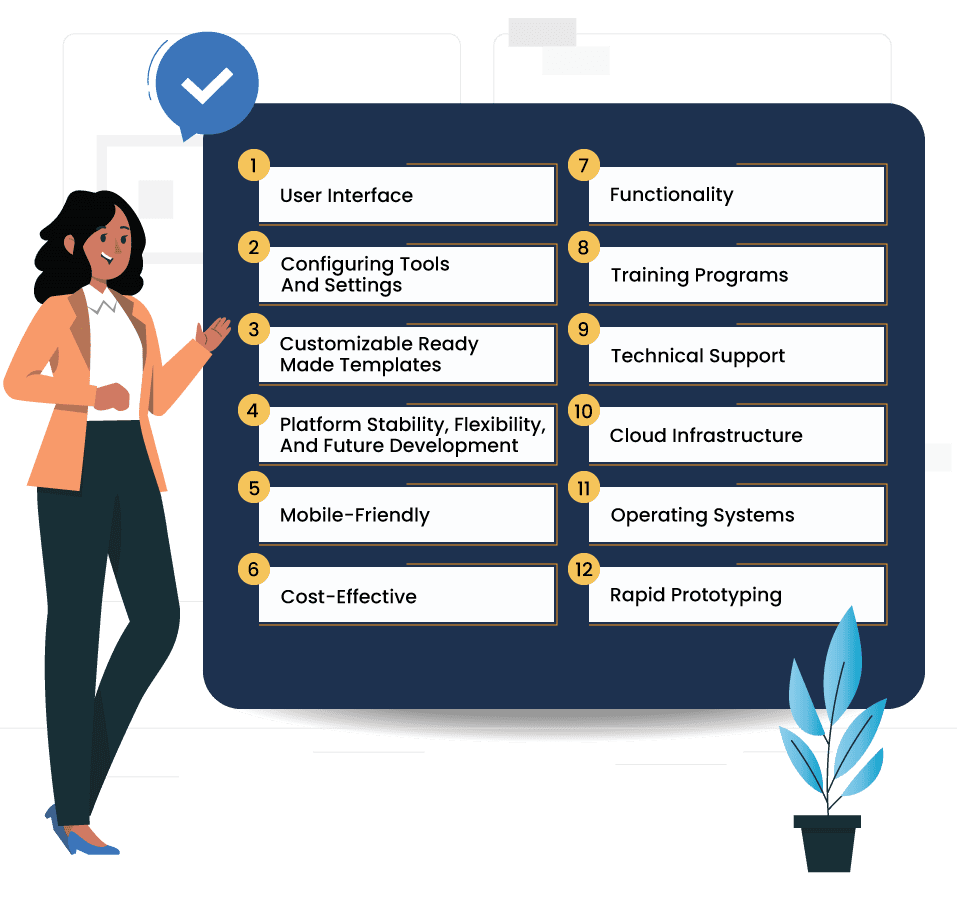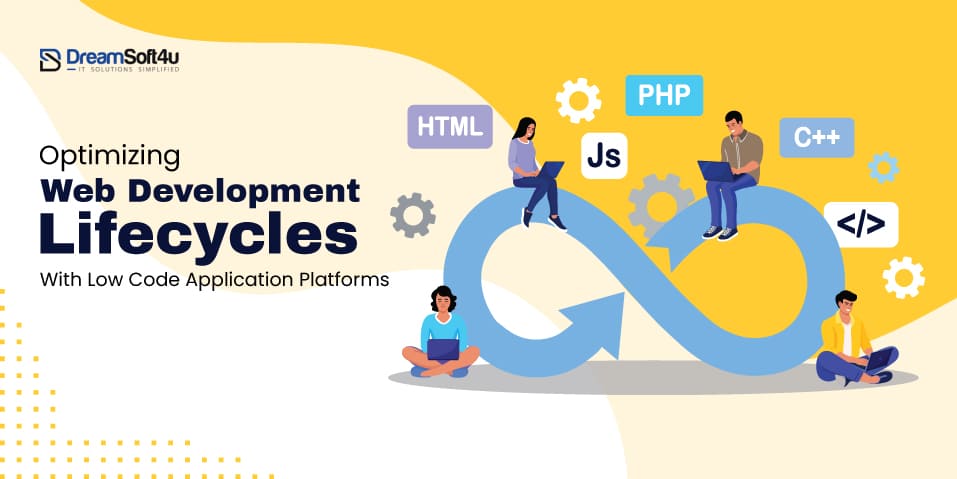Long development lifecycles and the need for specialized coding knowledge can frequently hamper the use of traditional web development approaches despite their high degree of control. It might impede companies in a market that demands efficiency and agility and inhibit innovation. Low-code application platforms (LCAPs) provide an appealing substitute by using a visual, user-friendly method to streamline the web development Lifecycles.
LCAPs enable a wider spectrum of users, ranging from business stakeholders with little coding knowledge to seasoned engineers looking to increase productivity. Leveraging drag-and-drop features, pre-built components, and easier integrations, LCAPs drastically cut down on complexity and development time. It encourages cooperation, which allows for the growth of innovation and the quick deployment of feature-rich web apps by companies looking to advance.
Table of Contents
ToggleWhat are Low Code Solutions in Software Development?
Low code App Development is magical when it comes to creating software with few lines of code. By providing a visual, drag-and-drop interface in place of complicated coding languages, they transform software development. Consider software building components! Low-code platforms offer pre-built elements that are readily combined and tweaked to produce practical applications. It makes it possible for a larger group of users to take part in development.
Hardcore coding abilities are optional when creating apps if a business analyst understands workflows. Professional developers can increase their productivity by automating tedious operations and concentrating on intricate features by utilizing low-code platforms. Low-code solutions may nevertheless require some coding to implement complex logic or special features. However, the overall process is streamlined, web development company bring software ideas to life much faster. It makes low-code solutions a game-changer, promoting innovation and agility in a world demanding rapid adaptation.
What is the Low-Code Web Development Lifecycle?
Low-code web development lifecycle is a process that helps you create, deploy, and manage web applications using low-code languages and platforms.
With low-code web development lifecycles, it’s easier to create prototypes and test iterations of your web applications quickly.
You can easily share and collaborate on web application projects with team members with tools like GitHub.
The process helps you efficiently manage updates to your web applications with versioning tools. It saves time by reducing the need for manual deployment processes.
Low-code web development lifecycle helps you quickly deploy your web applications to various platforms and devices. This process usually involves using automation software such as Jenkins and Jenkins X Preview.
Creating, testing, deploying, and managing web applications using low-code languages has made development more efficient and cost-effective for organizations of all sizes.
What is Low Code Automation?
Low-code automation software streamlines the process of automating tasks and actions in low-code development. This software helps you automate testing, deployment, versioning, and user management tasks. It also makes it easy to connect with different systems and applications for data analysis.
Built-in API and API development
Low code automation platforms offer built-in APIs that allow the API development team to access specific functionality without writing any code. This significantly reduces development costs and makes it easier to adapt system functionality over time.
Custom Integrations
Low code automation is a software development services that uses less code to achieve the same results as code written in a higher-code language.
Low code automation platforms allow developers to automate everyday tasks using simple commands, resulting in faster and more efficient development workflows.
Benefits of Low Code Application Platforms (LCAP)

These are some of the benefits Low Code Application Platforms offer:
App Development in Collaboration
The main benefits of Low code application platforms (LCAPs) are that they make it easy for the app development teams to develop web applications in collaboration. In addition, LCAPs provide a platform for code sharing, version control, and automatic testing, which makes it easy for teams to work on the same project without constantly checking in and out of code.
Enhances Agility
Low code application platforms (LCAPs) help businesses improve their agility by reducing the time it takes to develop a new web application.
These software development kits (SDKs) allow for quick iteration and the ability to quickly change and test the application. This allows businesses to respond more quickly to changes in customer behaviour or market conditions.
Accelerating Development Cycles
Low code application platforms (LCAPs) can help accelerate custom web development lifecycles by automating everyday tasks. When using LCAPs, developers do not need to code or edit applications manually; this can save time and energy. Additionally, LCP can help improve quality and consistency across multiple projects.
Reduced Cost
Low-code application platforms, such as LCAPs, can offer a cost-effective solution for developing web applications. LCAPs do not require any upfront investment compared to traditional web development frameworks. This means that you can start using LCAPs without worrying about the financial burden of software development.
Multi-experience is a Powerful Tool
Multi-experience is a powerful tool that can help you optimize your web development services. Low-code application platforms make it easy to develop, test, and deploy applications using multiple technologies simultaneously. This allows you to quickly adopt new technologies and improve software quality without rewriting existing code.
DreamSoft4u Since 2003
Get your free quote by the top professionals.
Limitations and How to Overcome Them
Despite their advantages, LCAPs have a few limitations. They can be challenging for experienced developers and may only work with some programming languages. Additionally, development teams must be willing to adopt specific software development approaches to take advantage of LCAPs.
You might get backed into a corner
Development teams should use LCAPs and other software development tools to overcome these limitations. For example, they can use GitHub and Travis CI to deploy applications and monitor code quality continuously.
Additionally, they should focus on automating repetitive tasks and building a modular codebase so that changes are easy to make.
Ultimately, using a low-code application platform will require hard work but can significantly benefit agile software development cycles and cost savings.
Debugging low-code applications is hard
Debugging low-code applications can be difficult. In particular, it can be challenging to track down and fix software development errors in code that is written using LCAPs.
Debugging tools such as source control systems (GitHub or Travis CI) and error tracking systems (JIRA or Asana) are essential for helping developers find and correct bugs quickly. Additionally, they should use developer best practices when coding to make debugging easier.
Low-code platforms are frequently referred to as “resume killers” by developers
Some developers may feel that Web Development Lifecycles using low-code platforms will hurt their resumes.
However, experience has shown that these platforms can be a powerful tool for software development teams.
In addition, only a few jobs require extensive programming skills. By using LCAPs and other tools, developers can still benefit from learning and mastering this technology.
How to Choose a Low-Code Integration Platform?
When choosing a low-code integration platform, it is essential to consider the specific needs of your business. Factors that you may want to consider include:

User Interface
The user interface of a low-code development platform should be intuitive and easy to use. A perfect UI/UX design service can help you quickly develop software applications without learning complex programming languages.
Quick start guides, chatbots, and tutorials are also essential, as they can teach you how to use the user interface and build software applications using LCAPs.
Configuring Tools and Settings
Configuring tools and settings is also essential when using a low-code development platform. For instance, you may need to configure project managers, source control systems, development environment software, etc.
Configuring tools and settings may be fine if you have extensive experience with specific development frameworks or programming languages.
Customizable Ready-Made Templates
Another benefit of using a low-code development platform is that you can easily customize ready-made templates. This allows you to quickly develop software applications with the same look and feel across different platforms and devices.
Furthermore, customizing templates makes migrating software applications from one development platform to another easy.
Platform Stability, Flexibility and Future Development
A key consideration when choosing a low-code development platform is stability, flexibility, and future development. The best platforms are reliable and easy to use. They also provide ample opportunities for customization so that your software applications remain unique.
Mobile-Friendly
Many low-code development platforms are also mobile-friendly. As a result, you can quickly develop software applications for devices like smartphones and tablets.
Cost-Effective
Low-code development platforms are also cost-effective. This means that you can develop software applications with minimal upfront costs. Some of the best low-code development platforms include Appcelerator, CodeNow, Codefresh, and Jolt.
Functionality
Some of the best low-code development platforms provide a wide range of functionality, including project management, source control, development environment software, and more. This makes them suitable for different types of software applications.
Training Programs
In addition to the benefits listed above, many low-code development platforms come with comprehensive training programs. This lets you quickly learn how to use the platform and develop software applications.
Technical Support
Most low-code development platforms come with comprehensive technical support. This ensures you can get help and use the platform to its full potential.
Cloud Infrastructure
Cloud-based software development platforms provide the potential to significantly speed up by allowing you to work on projects from anywhere in the world.
Operating Systems
Many low-code development platforms are also available for different operating systems. This means you can use them to develop software applications on various devices, including computers and mobile devices.
Rapid Prototyping
Some low-code development platforms include rapid prototyping tools. This lets you quickly create software applications in a mock-up format.
Planning to develop website though Low Code Platforms?
DreamSoft4u works with the latest trends.
Conclusion
Low-code platforms are similar to constructing web apps using pre-made Legos rather than having to write intricate instructions. It reduces the time needed for development, enables non-programmers to participate, and expedites the release of features. While low code isn’t ideal for every online project, it may revolutionize development by facilitating faster, more straightforward, and more cooperative work. Just keep in mind that you should select the appropriate platform for the task! These tools will undoubtedly influence web app development in the future as they continue to improve.
FAQ’s
Q1. Are low-code platforms suitable for all Web Development Lifecycles projects?
Although low code has many benefits, it is not a universally applicable solution. It’s possible that sophisticated programs with extremely specific functionality nevertheless need conventional coding techniques. However, low code is excellent at building business apps, user interfaces, and internal tools that may greatly improve user experience and expedite procedures.
Q2. Do I need coding experience to use a low-code platform?
Many low-code platforms are available to users with little to no coding skills, thanks to their intuitive UI and drag-and-drop capabilities. Still, having some technical knowledge is helpful, especially when setting up connectors and personalizing workflows.
Q3. How secure are low-code applications in Web Development Lifecycles?
Security is a very important factor. Reputable low-code platforms follow industry rules and place a high priority on data security. Selecting a platform with a solid security history is crucial, and you should make sure your development team adheres to the platform’s safe coding best practices.
Q4. Is it possible for low-code apps to interact with current systems?
Many low-code systems have strong integration capabilities. To facilitate smooth integration with current databases, cloud storage options, and other software programs you use inside your company, they frequently include built-in connectors or APIs (Application Programming Interfaces).
Q5. How much do low-code platforms cost on an ongoing basis?
Low-code platforms usually come with a range of price structures, which are frequently determined by factors like the application’s size, features used, and user count. Consider your options carefully and select a platform that provides an affordable answer to your project’s particular demands.



















